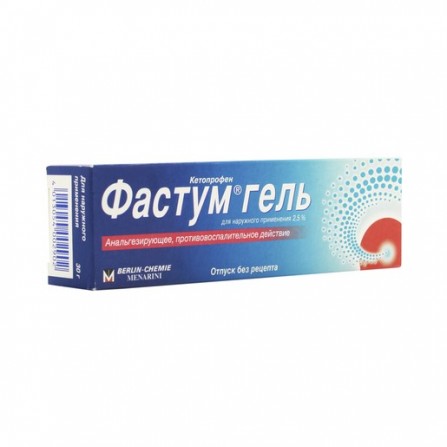More info
Active ingredients
Ketoprofen
Release form
Gel
Composition
100 g of gel contains: Active substance: ketoprofen 2.5 g. Supplementary substances: carbomer 940 - 1.5 g, ethanol 96% - 40 ml, non-erolic oil - 0.05 g, lavender oil (lavender oil, hybrid Lavender) - 0.05 g, trolamine (triethanolamine) - 2.8 mg, purified water - up to 100 g
Pharmacological effect
NSAID, a derivative of propionic acid. It has an analgesic, anti-inflammatory and antipyretic effect. The mechanism of action is associated with the inhibition of the activity of COX - the main enzyme in the metabolism of arachidonic acid, which is a precursor of prostaglandins, which play a major role in the pathogenesis of inflammation, pain and fever. The pronounced analgesic effect of ketoprofen is due to two mechanisms: peripheral (indirectly through suppression of prostaglandins) due to inhibition of prostaglandin synthesis in the central and peripheral nervous systems, as well as the action on the biological active other neurotropic substances that play a key role in the release of pain mediators in the spinal cord). In addition, ketoprofen has anti-bradykinin activity, stabilizes lysosomal membranes, causes significant inhibition of neutrophil activity in patients with rheumatoid arthritis. Suppresses platelet aggregation.
Pharmacokinetics
When taken orally and rectally, ketoprofen is well absorbed from the gastrointestinal tract. Cmax in plasma when taken orally is achieved in 1-5 hours (depending on the dosage form), when administered rectally, after 45-60 minutes, in a / m administration - in 20-30 minutes, in / in the administration - in 5 minutes. Plasma protein binding is 99%. Due to pronounced lipophilicity quickly penetrates the BBB. Css in plasma and cerebrospinal fluid lasts from 2 to 18 hours. Ketoprofen penetrates well into synovial fluid, where its concentration 4 hours after administration exceeds that in plasma. It is metabolized by binding with glucuronic acid and to a lesser extent due to hydroxylation. by the kidneys and to a much lesser extent through the intestines. T1 / 2 ketoprofen from plasma after oral administration is 1.5-2 hours, after rectal administration - about 2 hours, after i / m administration - 1.27 hours, after intravenous administration - 2 hours.
Indications
pain of traumatic origin (bruises, sprains and muscles); tension and stiffness of the neck muscles; lumbago (pain in the lumbosacral spine); muscular and bone-joint pain of a rheumatic origin (eg, osteoarthritis).
Contraindications
individual hypersensitivity to ketoprofen or other components of the drug, acetylsalicylic acid or other NSAIDs (indications in the history of bronchospasm, urticaria or rhinitis caused by taking acetylsalicylic acid) and fenofibrate; increased skin sensitivity to the effects of solar radiation (photosensitization). a history of ketoprofen, tiaprofenic acid, fenofibrate, sunscreens and perfumes; sun exposure on the treated areas, including a tanning bed for The course of the drug use and 2 weeks after the mococonus dermatosis, eczema, infected abrasions, wounds (at the site of gel application), children under 12 years old (efficacy and safety have not been studied), pregnancy and lactation period.
Precautionary measures
Do not exceed recommended doses.
Use during pregnancy and lactation
Contraindicated for use in the III trimester of pregnancy. In the first and second trimesters of pregnancy, the use of ketoprofen is possible in cases where the potential benefit to the mother outweighs the potential risk to the fetus. If it is necessary to use ketoprofen during lactation, breastfeeding is recommended to stop.
Dosage and administration
For external use. When using a tube: a strip of gel with a length of 5-10 cm is applied with a thin layer on the affected area or skin over the inflammation center 1-2 times a day and lightly rubbed. When using a dispenser container: press twice on the dome dispenser (Fig. 1.) or on the base (Fig. 2) until the appearance of the gel. It is recommended to keep the container in a horizontal position. Apply a thin layer of gel on the affected area or the skin over the inflammation 1-2 times a day and lightly rubbed. The amount of gel applied depends on the size of the treated area. It is possible to use Fastum in combination with physiotherapy (phonophoresis and iontophoresis). The course of treatment is 10 days.
Side effects
On the part of the skin: Infrequently: erythema, itching, eczema; Rarely: photosensitization, bullous dermatitis, urticaria; Very rare: contact dermatitis, angioedema. From the gastrointestinal tract: Very rare: peptic ulcer, bleeding, diarrhea. : Very rare: anaphylactic reactions, hypersensitivity reactions. From the urinary system: Very rare: aggravation of the course of renal failure.
Overdose
No cases of overdose have been reported.
Interaction with other drugs
With simultaneous use of ketoprofen with other NSAIDs increases the risk of erosive and ulcerative lesions of the gastrointestinal tract and bleeding; with antihypertensive drugs (including beta-blockers, ACE inhibitors, diuretics) - it is possible to reduce their action; with thrombolytics - increased risk of bleeding. When used simultaneously with acetylsalicylic acid, ketoprofen can decrease its binding to plasma proteins and increase its plasma clearance; with heparin, ticlopidine - increased risk of bleeding; with lithium preparations - it is possible to increase the lithium concentration in the blood plasma to toxic by reducing its renal excretion. If used simultaneously with diuretics, the risk of developing renal failure due to reduced renal blood flow due to inhibition of prostaglandin synthesis and hypovolaemia increases. If used simultaneously with probenecid may decrease the clearance of ketoprofen and its binding to plasma proteins; with methotrexate - possibly increased side effects of methotrexate. With the simultaneous use of warfarin may develop severe, sometimes fatal bleeding.
special instructions
With extreme caution used in patients with liver and kidney diseases, gastrointestinal diseases in history, dyspeptic symptoms, immediately after serious surgical interventions. In the process of treatment requires systematic monitoring of liver and kidney function.





